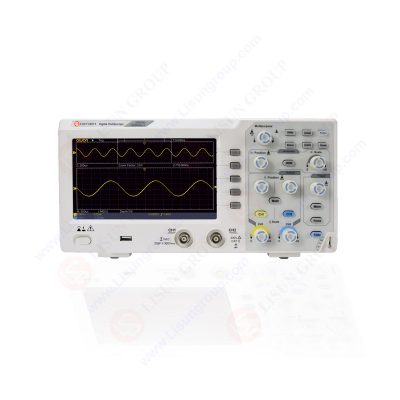
What is an oscilloscope?
An oscilloscope is an electronic device used to measure alternating current (AC) or pulse current waveforms. It consists of an electronic tube amplifier, a scanning oscillator, and a cathode ray tube. It can be used to observe the form of current, measure frequency, voltage intensity, and other parameters. It can also be used to observe the periodic physical processes that can be transformed into electrical effects.
Oscilloscopes are a multifunctional measuring instrument that can realize the time and numerical plotting of the continuous and variable signals of electric circuits. They are commonly used as a tool for measuring circuits and signals. Oscilloscopes are mainly divided into analog oscilloscopes and digital oscilloscopes. An analog oscilloscope uses an electron beam emitted by an electron gun which is focused on a fluorescent material screen to form an image. Digital oscilloscope is implemented through software and data acquisition, A/D conversion. Digital oscilloscopes can also be divided into different types, such as digital storage oscilloscopes, digital fluorescent oscilloscopes, and sampling oscilloscopes. Using an oscilloscope for measuring equipment can more effectively analyze the signal characteristics in the circuit and locate faults.
The basic structure of the oscilloscope consists of a display circuit and a control circuit, the former of which includes the oscilloscope tube, electron gun, deflection system, and fluorescent screen. The oscilloscope tube can continuously convert the changing voltage into a display image, thus performing a visual inspection of the voltage change.
The principle of the digital oscilloscope is to use an A/D converter to convert the analog signal into a digital signal, then use software programming to analyze the digital signal, and finally display the digital signal into an analog signal on the monitor. This can be used to display waveforms and to perform various data measurements or analyses.
Digital oscilloscope is an important tools for collection, triggering, display and analysis technology. The emergence of digital oscilloscopes has changed the traditional measurement technology, providing reliable tools for engineers to quickly and accurately solve measurement challenges. The unique advantages of digital oscilloscope have enabled it to be widely used by engineers, but if they are used improperly, it can produce large measurement errors, which can affect the effectiveness of the task completion.
Digital oscilloscope is a type of electronic testing instrument used to measure electrical signals. They are especially useful for industrial, automotive, and medical applications, as well as for educational purposes. Oscilloscopes help engineers and technicians “see” the behavior of the electronic signals they are testing, helping them diagnose system faults or measure the performance of their system components.
Traditional analog oscilloscopes use analog voltmeter-style controls and display signals on a CRT (cathode ray tube) display. Modern digital oscilloscopes, however, are much more powerful and offer a variety of features and capabilities. They use digital controls to allow for collecting and analyzing data digitally and displaying it on an LCD or other computer display. By exploiting the power of digital technology, modern digital oscilloscope can measure a wider range of signals, display a wealthier range of parameters, and store results for extended periods of time.
When examining signals engaged in complicated systems, digital oscilloscopes offer a range of higher-end features, like deep memory, which allow technicians to zoom in on and analyze smaller parts of a signal in minute detail. They also feature automated measurements, which allow technicians to quickly and easily calculate the most important characteristics of a signal from its display, including voltage, time, frequency, and rise and fall times. Digital oscilloscope also allow technicians to arbitrate their test data by connecting your instrument to your PC, giving you the ability to save, print, and share results with other technicians.
Digital oscilloscope also allow you to link up multiple instruments and achieve a more comprehensive view of your system's behavior. Digital oscilloscopes feature an array of connectivity options, allowing you to connect several instruments together for simulating complex systems, such as embedded networks. Digital oscilloscopes further enable inter-instrument analysis and comparison, allowing you to measure signals from several different components of a system over time at the same time.
Because of their powerful capabilities, digital oscilloscope offer tremendous advantages to engineers and technicians, allowing them to gain a better understanding of the signal behavior at their fingertips. For the same reasons, digital oscilloscopes have grown in popularity in many fields and are now used in a variety of applications, from medical to automotive to defense. Digital oscilloscopes have become must-have instruments for any technician or engineer looking to gain insight into the behavior of the signals they measure.
Lisun Instruments Limited was found by LISUN GROUP in 2003. LISUN quality system has been strictly certified by ISO9001:2015. As a CIE Membership, LISUN products are designed based on CIE, IEC and other international or national standards. All products passed CE certificate and authenticated by the third party lab.
Our main products are Goniophotometer, Integrating Sphere, Spectroradiometer, Surge Generator, ESD Simulator Guns, EMI Receiver, EMC Test Equipment, Electrical Safety Tester, Environmental Chamber, Temperature Chamber, Climate Chamber, Thermal Chamber, Salt Spray Test, Dust Test Chamber, Waterproof Test, RoHS Test (EDXRF), Glow Wire Test and Needle Flame Test.
Please feel free to contact us if you need any support.
Tech Dep: Service@Lisungroup.com, Cell/WhatsApp:+8615317907381
Sales Dep: Sales@Lisungroup.com, Cell/WhatsApp:+8618117273997
https://www.lisungroup.com/news/technology-news/oscilloscope.html
.jpg)
Comments
Post a Comment